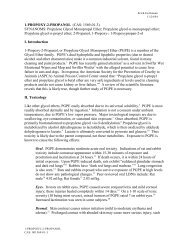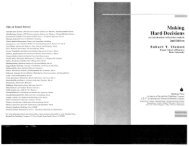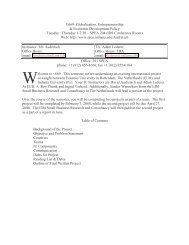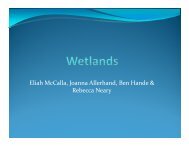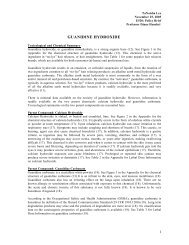Environmental Economics and Policy – V625
Environmental Economics and Policy – V625
Environmental Economics and Policy – V625
Create successful ePaper yourself
Turn your PDF publications into a flip-book with our unique Google optimized e-Paper software.
f. What do your answers to questions (d) <strong>and</strong> (e) tell you about which<br />
instrument is most appropriate for this Death Valley application. What is<br />
the general (Weitzman) proposition we discussed in class for instrument<br />
choice under uncertainty <strong>and</strong> is it consistent with your prescription?<br />
Given the uncertainty, the quantity-based approach is more appropriate. The<br />
general principle said that when the MD curve is flat (shallow slope) relative<br />
to the MS curve, then a price-based approach is appropriate. When the MD<br />
curve is steep relative to the MS curve (as in the case), then the quantity-based<br />
approach is preferred (i.e., minimizes expected DWL).<br />
2. (10) Suppose you are the head of the Illiana State <strong>Environmental</strong> Protection<br />
Service. You have been charged with implementing the state water quality<br />
protection program. The primary polluters in your state are pulp <strong>and</strong> paper<br />
mills. The technology for water pollution abatement at the mills is pretty<br />
uniform across the industry. Given current regulatory st<strong>and</strong>ards, the marginal<br />
cost of abatement when firms are in compliance is $12,000/ton. Your primary<br />
mechanism for inducing compliance with st<strong>and</strong>ards is fines for exceeding the<br />
st<strong>and</strong>ard, where violations are detected by a team of inspectors. Bowing to<br />
industry pressure, the state legislature has limited the amount of a fine to<br />
$100,000 per ton in excess of the permitted amount. Suppose you are<br />
designing your monitoring program. To assure that firms have an incentive to<br />
abate at the proper level, what goal are you going to set regarding the<br />
probability that a violation will be detected? Provide a numeric response.<br />
MC = $12,000/ton. We want the expected fine for noncompliance, E(fine), to be at<br />
least as large as the MC.<br />
E(fine) = pr(detection) * fine for detection > $12,000/ton<br />
= pr(detection) * $100,000/ton > $12,000/ton<br />
=> pr(detection) > 0.12 ore 12%<br />
3. (10) You are evaluating a project to save the precariously endangered polka<br />
dotted egret. The plan in front of you is given a 50-50 chance of working. The<br />
cost of the plan is $5 million. If it succeeds, the benefit of saving the polka<br />
dotted egret is estimated to be $9million. If it fails, there are no benefits.<br />
Does this project pass the cost-benefit test? Show your analysis.<br />
E(Benefits) = 0.5 ($9.0M) + 0.5 ($0) = $4.5M<br />
Costs = $5M<br />
E(Net benefits) = $4.5M - $5.0M = -0.5M => does not pass the CBA test.<br />
4. (10) Gasoline is generally considered a private market good. However, as we<br />
all know, the combustion of gasoline can have various negative environmental<br />
effects on global warming, acid rain, particulate levels, etc. Suppose the<br />
3



